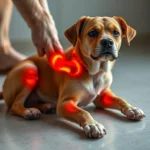
Introduction
Dog health care is a vital aspect of pet ownership, encompassing everything from nutrition to regular vet check-ups. Among the many health concerns dog owners face, skin health is particularly important, as it can significantly affect a dog’s overall well-being. One common skin issue that many dogs encounter is hotspots. These are localized areas of inflammation and infection that can cause discomfort and distress to your furry friend.
Hotspots are often characterized by redness, itching, and sometimes oozing. They can be caused by various factors, including allergies, parasites, and skin infections. Understanding hotspots and how to manage them is crucial for maintaining your dog’s health. In this article, we will explore the best shampoos for hotspots, helping you choose the right product to soothe your dog’s skin and promote healing.
Understanding Hotspots
What Are Hotspots?
Hotspots, medically known as acute moist dermatitis, are areas of inflamed and infected skin that can appear suddenly. They are often very itchy, leading dogs to scratch, bite, or lick the area, which exacerbates the problem. Common symptoms include:
- Red, inflamed skin
- Oozing or crusty lesions
- Excessive licking or scratching
- Foul odor from the affected area
Causes of Hotspots
A variety of factors can lead to the development of hotspots, including:
-
Allergies: Dogs can be allergic to certain foods, environmental factors like pollen, or even flea bites. These allergies can lead to itching and inflammation, creating a perfect environment for hotspots to develop.
-
Parasites: Fleas, ticks, and mites can irritate the skin, causing your dog to scratch excessively. This scratching can lead to open wounds and subsequent infections.
-
Skin Infections: Bacterial or fungal infections can also result in hotspots, particularly if the skin has been compromised by scratching or biting.
-
Excessive Moisture or Humidity: Dogs that frequently swim or live in humid environments may develop hotspots, as moisture can irritate the skin.
Risk Factors
Some breeds are more prone to hotspots than others, including Golden Retrievers, Labrador Retrievers, and St. Bernards. Additionally, seasonal changes, particularly during warmer months, can increase the likelihood of hotspots due to higher humidity and increased insect activity.
Importance of Proper Skin Care
Regular Grooming
Regular grooming is essential for preventing hotspots. By brushing your dog’s coat, you can remove dirt, debris, and loose hair that may irritate the skin. Additionally, grooming helps distribute natural oils, promoting skin health.
Recommended Grooming Tools and Techniques
- Brush: Use a slicker brush or a bristle brush to effectively remove loose fur and stimulate the skin.
- Bathing: Regular baths with appropriate dog shampoos can help maintain clean and healthy skin.
Nutrition and Skin Health
A balanced diet plays a crucial role in maintaining healthy skin. Look for dog food that contains high-quality proteins, fatty acids, and essential vitamins.
Key Nutrients to Look For
- Omega-3 and Omega-6 Fatty Acids: These promote a healthy coat and skin.
- Vitamins A, E, and B: Vital for skin health and repair.
Recognizing Early Signs of Skin Issues
Being vigilant about your dog’s skin health can help catch problems early. Regularly check your dog’s body for any unusual bumps, redness, or excessive scratching. Early intervention can prevent hotspots from developing.
Overview of Dog Shampoos
Types of Dog Shampoos
Choosing the right shampoo is crucial for managing hotspots. There are various types of dog shampoos available:
- Medicated Shampoos: These contain specific ingredients designed to treat skin conditions, including hotspots.
- Regular Shampoos: While they may clean the coat, they may not address underlying skin issues.
Natural vs. Chemical-Based Shampoos
While chemical-based shampoos can be effective, many pet owners prefer natural alternatives. Natural shampoos often contain soothing ingredients that are less likely to irritate sensitive skin.
Ingredients to Look For
When selecting a shampoo, pay attention to the ingredients:
-
Antimicrobial Agents: Look for shampoos containing chlorhexidine or benzoyl peroxide, which can help combat infections.
-
Soothing Ingredients: Ingredients like aloe vera and oatmeal can calm irritated skin and provide relief.
-
Hypoallergenic Properties: For dogs with sensitive skin, hypoallergenic shampoos can minimize the risk of irritation.
Ingredients to Avoid
To protect your dog’s skin, avoid shampoos containing:
-
Harsh Chemicals: Ingredients like sulfates and parabens can strip the skin of its natural oils.
-
Artificial Fragrances and Dyes: These can cause allergic reactions and sensitivities.
Best Shampoos for Hotspots
Top Recommended Shampoos
Here are some of the best shampoos for hotspots that are well-reviewed by pet owners and veterinarians alike:
Product 1: Vet’s Best Allergy Itch Relief Shampoo
- Key Ingredients: Aloe vera, neem oil, and vitamin E.
- Pros: Soothes itching, reduces inflammation, and contains natural ingredients.
- Cons: Some dogs may require multiple washes for optimal results.
- Price Range: $10-$15.
Product 2: Pet MD Medicated Shampoo
- Key Ingredients: Chlorhexidine and ketoconazole.
- Pros: Highly effective against bacterial and fungal infections; vet-recommended.
- Cons: Not suitable for frequent use; may dry out the skin if overused.
- Price Range: $15-$20.
Product 3: Earthbath All Natural Oatmeal & Aloe Shampoo
- Key Ingredients: Oatmeal, aloe vera, and vitamin E.
- Pros: Gentle, natural ingredients perfect for sensitive skin; pH-balanced.
- Cons: May not be strong enough for severe hotspot cases.
- Price Range: $12-$18.
Comparison of Shampoos
| Shampoo Name | Key Ingredients | Pros | Cons | Price Range |
|---|---|---|---|---|
| Vet’s Best Allergy Itch Relief | Aloe vera, neem oil | Soothes itching, natural ingredients | Requires multiple washes | $10-$15 |
| Pet MD Medicated Shampoo | Chlorhexidine, ketoconazole | Effective against infections | May dry out skin if overused | $15-$20 |
| Earthbath All Natural Shampoo | Oatmeal, aloe vera | Gentle, pH-balanced | Not strong enough for severe cases | $12-$18 |
How to Use Shampoo Effectively for Hotspots
Bathing Techniques
Bathing your dog properly can enhance the effectiveness of the shampoo. Here’s a step-by-step guide:
- Prepare the Bath: Use lukewarm water and ensure the bathing area is comfortable.
- Wet the Coat: Thoroughly wet your dog’s coat, avoiding the eyes and ears.
- Apply Shampoo: Use a generous amount of shampoo and lather it into the affected areas gently.
- Rinse Thoroughly: Ensure all shampoo is washed out to prevent irritation.
- Dry the Dog: Use a towel to dry your dog, focusing on the hotspots. Avoid using a hairdryer as it may irritate the skin.
Recommended Bathing Frequency
For dogs prone to hotspots, bathing once every 2-4 weeks with a suitable shampoo can help keep the skin clean and healthy. However, always consult your veterinarian for personalized advice.
Post-Bath Care
After bathing, it’s essential to prevent moisture buildup, as this can exacerbate hotspots.
- Dry Thoroughly: Ensure your dog is completely dry, particularly in areas prone to moisture.
- Monitor the Area: Keep an eye on the treated hotspots for any signs of improvement or worsening.
For severe hotspots, your vet may recommend topical creams or additional treatments to assist healing.
Additional Treatments for Hotspots
Veterinary Treatments
If hotspots persist despite at-home care, it’s crucial to consult a veterinarian. They may recommend:
- Prescription Medications: To control inflammation and infection.
- Topical Treatments: Such as sprays or creams specifically designed for hotspots.
Home Remedies
While some home remedies can soothe hotspots, always consult your vet before trying them. Potential remedies include:
- Cold Compress: Applying a cold compress can relieve itching and reduce inflammation.
- Apple Cider Vinegar: Diluted apple cider vinegar can help with itching but should be used cautiously.
Cautions and Considerations for Home Treatments
Always ensure any home remedy is safe for your dog. Some natural substances may irritate sensitive skin or interact with other medications.
Preventing Future Hotspots
Regular Skin Checks
Performing regular skin checks can help catch hotspots before they become severe. Look for any changes in your dog’s skin, including:
- Redness or swelling
- Scabs or sores
- Excessive scratching or licking
Environmental Management
Reducing allergens and irritants in your home can significantly improve your dog’s skin health.
- Clean Environment: Regularly vacuum and wash your dog’s bedding to minimize dust and allergens.
- Flea Prevention: Use veterinarian-recommended flea and tick preventatives to reduce the risk of infestations.
Maintaining a Healthy Lifestyle
A healthy lifestyle contributes to overall skin health. Ensure your dog receives:
- Regular Exercise: Physical activity helps maintain a healthy weight and reduces stress.
- Mental Stimulation: Engaging your dog’s mind can also reduce behavioral issues that may lead to hotspots.
Conclusion
Addressing hotspots promptly is crucial for your dog’s health and comfort. By choosing the right shampoo and implementing a proper care routine, you can significantly improve your dog’s skin condition. Regular grooming, a balanced diet, and monitoring for early signs of skin issues are essential steps in preventing hotspots. Always consult your veterinarian for persistent issues to ensure your beloved pet receives the best care possible.









